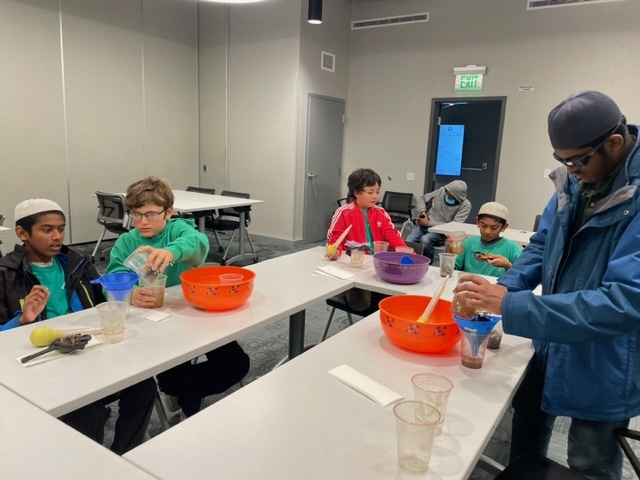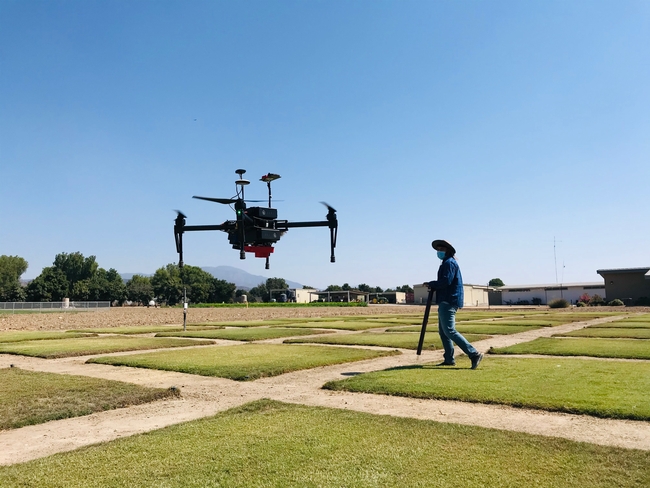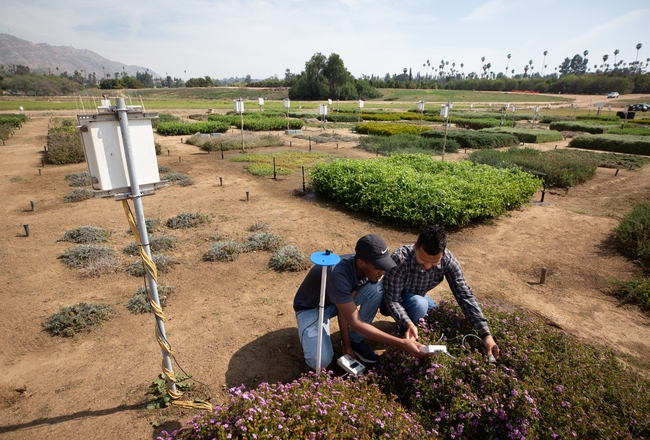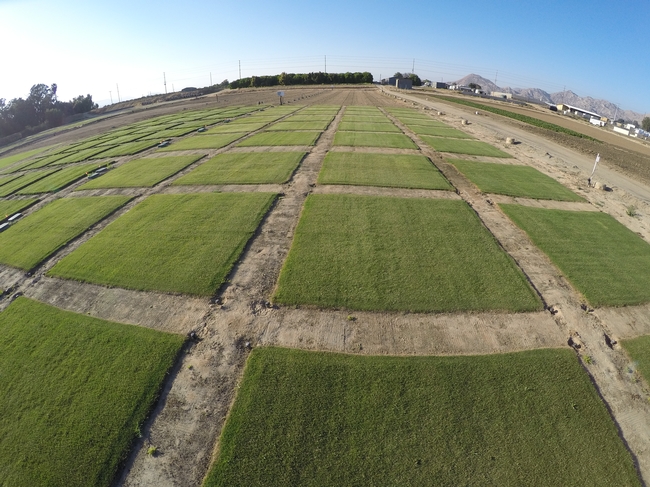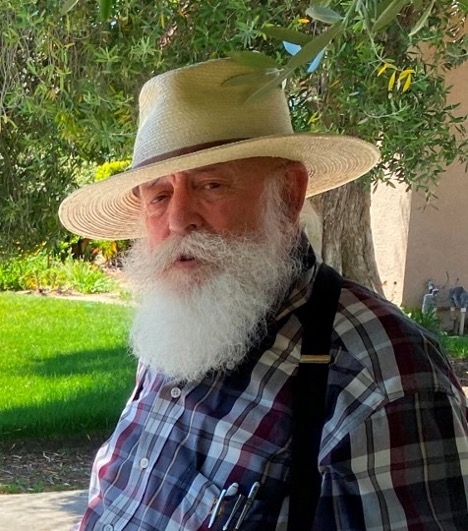Posts Tagged: conservation
UC Davis Professor Louie Yang: On Conserving the Western Monarch Population
"Recent studies have continued to shed light on the ecology of monarch butterflies (Danaus plexippus) in western North America. These studies have...
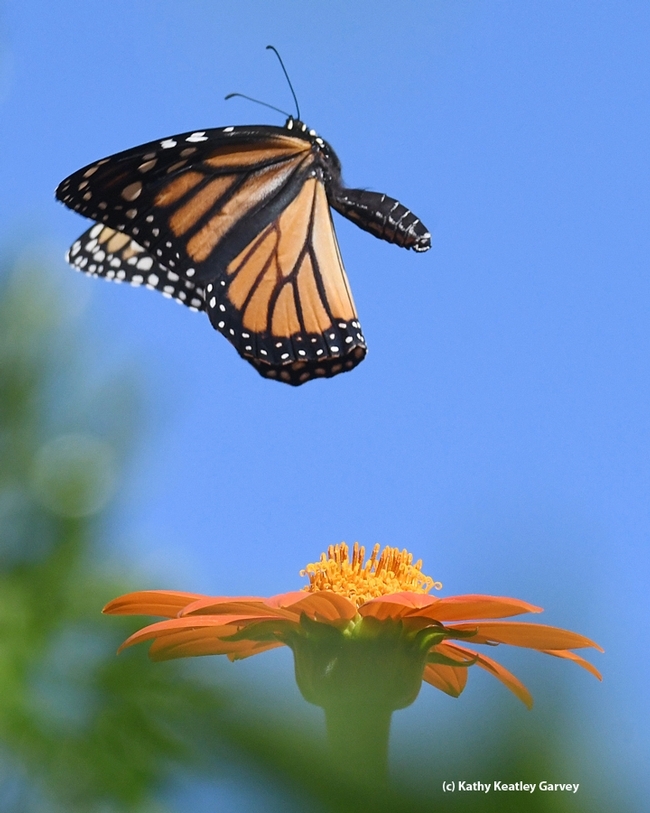
A monarch leaving a Mexican sunflower, Tithonia rotundifola. This image was taken in a pollinator garden in Vacaville. (Photo by Kathy Keatley Garvey)
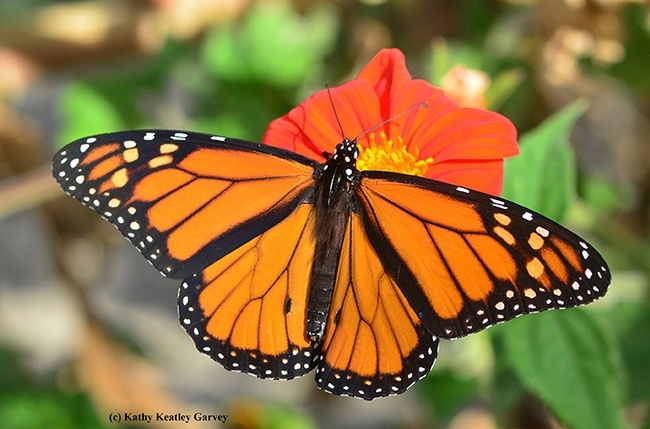
A male monarch nectaring on a Mexican sunflower, Tithonia rotundifola, in Vacaville. (Photo by Kathy Keatley Garvey)
Los Angeles 4-H program cultivates future generation of water stewards
Ibrahim Yaaseen, member of the Palos Verdes Peninsula (PVP) 4-H club, grabs a hard hat and places it on top of his head. He then reaches for a bright orange safety vest and goggles to complete his safety gear outfit before joining the rest of his club members who are dressed the same.
The 4-H Youth Development Program of Los Angeles is already thinking about the future of water management and turned to the West Basin Municipal Water District in El Segundo to gain a deeper understanding of the precious resource we often take for granted.
The University of California 4-H Youth Development Program is managed through local Cooperative Extension offices. Through hands-on learning experiences, 4-H empowers youth to reach their full potential and enables them to build self-esteem, connect with their community and emerge as leaders.
Dee Keese, community club leader for the PVP 4-H club, coordinated an exclusive and interactive tour of West Basin's Edward C. Little Water Recycling Facility for the club's monthly marine biology meeting in December 2022.
Eager to inspire a stronger appreciation for water, Janel Ancayan, the West Basin's education coordinator, challenged the youth to build their own water filters using materials including fabric, a strainer, and a funnel. Since no specific directions were given, the activity challenged each student's science and engineering skills, such as carrying out an investigation, designing a solution, and communicating information with team members.
During the tour, students saw firsthand the impressive equipment and essential staff members that help to produce nearly 40 million gallons of recycled water each day. At the end of the day, students left with a deeper understanding of water resources and felt empowered to do their part to conserve water sources.
“We learned that recycling water helps to conserve our limited water supply and improves the environmental condition of our coastal waters,” said Yaaseen. “We ultimately learned a great deal about how to conserve water for future generations and that water conservation is one of the most important elements in combating climate change.”
Though Keese has volunteered as community club leader for 48 years, this is only the second time she has partnered with the West Basin. “I like to mix it up,” she said. “I'm always looking for community organizations and local businesses to partner with because these are places that the kids will likely interact with since they're nearby.”
Regardless, it's leaders like Keese and programs like 4-H that encourage water stewards like Ancayan. “I'm always so humbled and inspired when teachers make it a point to come out and visit our facility. In Southern California especially, [water] is not something we think about,” Ancayan said.
Even in a drought, water continues to flow from our faucets allowing us to shower, wash dishes or water the lawn. It's no wonder why water conservation is not always top of mind, especially for consumers. Educating the public, and targeting the younger generation, however, is a great start to prepare for the future.
West Basin offers a variety of educational programs that focus on different age groups. Many of them involve hands-on learning like the Teach and Test volunteer program, a partnership with the Surfrider Foundation, where high school students test samples of coastal water for bacteria, and then publicly share their findings to contribute to water quality monitoring in the area.
According to Yaaseen, the time spent with Ancayan at the West Basin was “one-of-a-kind” and provided a “golden opportunity” to learn why water recycling facilities are important. Ancayan hopes that her time spent with students ultimately influences them to consider a career in water.
“It's not a glamorous job but I'm really passionate about the next generation of water workers,” she said. “I hope that once they see the engineering, the excitement of these scientists that work in our laboratory and everything in between, that they start to think about water as a future career path.”
For those interested in joining 4-H, visit https://4h.ucanr.edu/Members/
To read this story in Spanish, please visit:
Programas 4-H de Los Ángeles forman a la futura generación de administradores de los recursos hídricos
https://ucanr.edu/blogs/blogcore/postdetail.cfm?postnum=57063
UCCE water management expert helps save water, increase supply in SoCal
Earlier this year, officials in Southern California declared a water shortage emergency resulting in restrictions such as limiting outdoor water use to one day of the week. While mandatory restrictions vary across the region, Amir Haghverdi, UC Cooperative Extension specialist and associate professor of agricultural and urban water management at UC Riverside, is using research to pinpoint irrigation strategies that will help communities reduce their demand for water and increase supply.
Haghverdi and his team are responding to a hotter and drier California by working to identify changes that can make a substantial difference in water savings.
While behavioral changes such as preventing leaks and turning the faucet off while brushing teeth can help, Haghverdi's research focuses on methodical changes like stressing green spaces, planting drought-tolerant plant species, using non-traditional water sources, and investing in technology to better control water use.
Testing a lawn's limits
For six years, Haghverdi and his team have performed stress tests on turfgrass to identify the lowest percent of evapotranspiration rate (ETo) that it can withstand and still survive. To do this, Haghverdi's team applies different percentages of ETo, obtained from weather stations, and monitors the performance of each landscape species over time.
While both cool-season and warm-season species can be stressed and still maintain their aesthetic value for a few weeks to several months, Haghverdi's results showed that warm-season turfgrass species require less water and can withstand water stress better.
The actual duration that people can apply less water depends on the type of turfgrass, the weather conditions and the stress level. For example, results showed that hybrid bermudagrass (a warm-season turfgrass) during summer in inland Southern California could keep its aesthetic value above the minimum threshold for 30 to 50 days, depending on the weather conditions, with irrigation application as low as 40% ETo.
In contrast, tall fescue, a cool-season turfgrass, even with 20% more water, showed signs of stress after only a few weeks and could not maintain its minimum acceptable quality.
Plant drought-tolerant species
Haghverdi's work demonstrates that when water conservation is the goal, alternative groundcover species are clearly superior to all turfgrass species and cultivars that they have tested so far. In fact, his team has identified drought-tolerant species that can maintain their aesthetic values with a third to a quarter less water than cool-season turfgrass (as low as 20% ETo) and can even withstand no-irrigation periods.
Furthermore, extensive field trials showed that new plant species from different regions could be as resilient as native species in withstanding drought and heat stress while maintaining their aesthetic beauty and cool canopy. Occasionally, they have outperformed native species, underscoring the advantages of drought- and heat-tolerant species that are non-native.
Based on Haghverdi's preliminary results for minimum irrigation requirement in inland Southern California, creeping Australian saltbush, a non-native species originally from Australia, and coyote bush, native to California, were top performers. Considering cooling benefits, drought tolerance and sensitivity to over-irrigation, creeping Australian saltbush performed the best.
Counties are already using recycled water
Although he recommends renewing your landscape with drought-tolerant or low-water use greenery and identifying how long your green spaces can live without water, Haghverdi acknowledges that, while contradictory, the cooling benefits of landscape irrigation are essential in Southern California.
“This is one of the tradeoffs of water conservation,” said Haghverdi. “If the only goal is to conserve water, maybe people will conclude that we don't have enough water to irrigate landscape.”
Water conservation efforts could influence counties to stop or reduce landscape irrigation. The consequences, however, would result in hotter environments due to the heat island effect. The loss of landscapes means that the sun's energy will be absorbed into the ground, instead of prompting transpiration in plants, which helps keep environments cool.
Thus, stressing green spaces and investing in drought-tolerant plant species help reduce the demand for water, but increasing water supply is just as vital. Haghverdi urges Southern California counties to prioritize a supplemental water supply such as recycled water – an approach already implemented in Ventura, Orange and San Diego counties.
The Metropolitan Water District of Southern California's Pure Water Southern California Program, formerly known as the Regional Recycled Water Program, aims to do just that. In partnership with the Los Angeles County Sanitation Districts, the program will further purify wastewater to produce a sustainable source of high-quality water for the region.
According to the program's website, this would “produce up to 150 million gallons of water daily when completed and provide purified water for up to 15 million people, making it one of the largest water reuse programs in the world.”
Smart controllers save time, money and water
Making the best use of the water you already have relies on efficiency. Sprinklers that are poorly placed, for example, are not as effective as they could be.
“What I see often while walking my dog in the neighborhood is that there's a lot of runoff, bad irrigation and bad timing like when it's windy,” Haghverdi observed. “People usually set their irrigation timer and then forget it, but they don't adjust it based on the season or weather parameters. That's not going to help us conserve water, a precious resource, in California.”
Thankfully, Haghverdi and his team have done extensive research on smart irrigation controllers, which, simply put, are irrigation timers with a sensor built in. Generally, there are two types of smart irrigation controllers: weather- and soil-based controllers.
Weather-based controllers use evapotranspiration data to automatically adjust their watering schedule according to local weather conditions. Soil-based controllers measure moisture at the root zone and start irrigating whenever the reading falls below a programmed threshold.
Smart controllers that have flowmeters can detect leaks and be activated automatically, whereas rain sensors can stop irrigation during rainfall. Although both additions are ideal for large irrigation landscapes such as parks and publicly maintained green spaces, rain sensors are easy to install and effective for residential areas too.
When asked about cost being a hindrance, Haghverdi responded, “Not a lot of people know that there are grants for smart controllers – some that will pay either all or a majority of the cost.”
To check if grants are available in your area, interested individuals are encouraged to contact their local water provider.
“We need to move towards autonomous and smart irrigation [strategies], and water management in urban areas. That's the future. If we can build autonomous cars, why can't we build smart water management systems that apply the right amount of water to each plant species, can detect leaks and prevent water waste?” said Haghverdi.
To learn more about or stay updated on Haghverdi's research, visit www.ucrwater.com.
Monarch Butterflies: Closer to Extinction
It was a good news/bad news/sad news kind of day on July 21 when the International Union for Conservation of Nature...
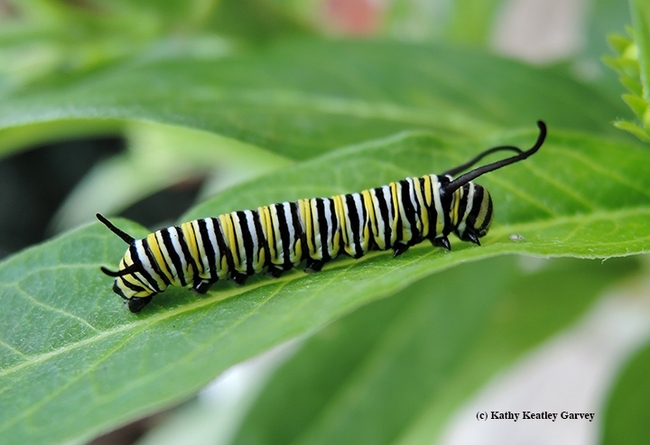
A monarch caterpillar munching away on its host plant, milkweed, in a Vacaville, Calif., garden. (Photo by Kathy Keatley Garvey)
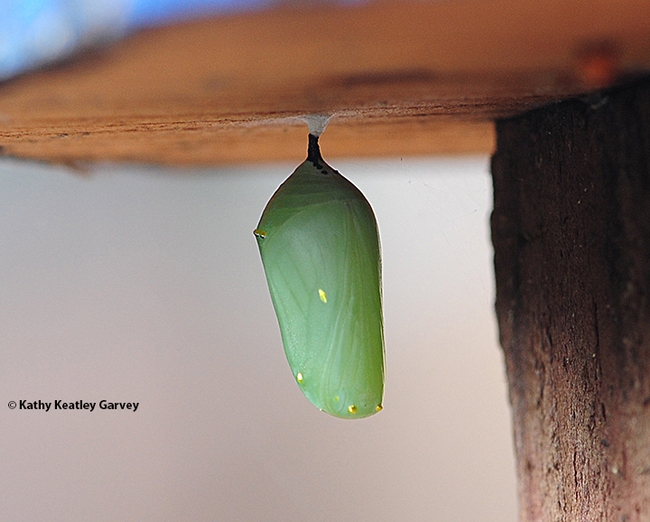
A monarch chrysalis attached to the underside of a bird feeder. (Photo by Kathy Keatley Garvey)
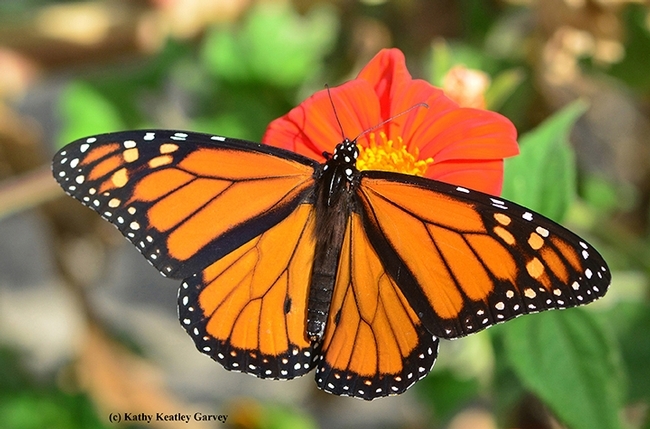
A male monarch butterfly spreads its wings. (Photo by Kathy Keatley Garvey)
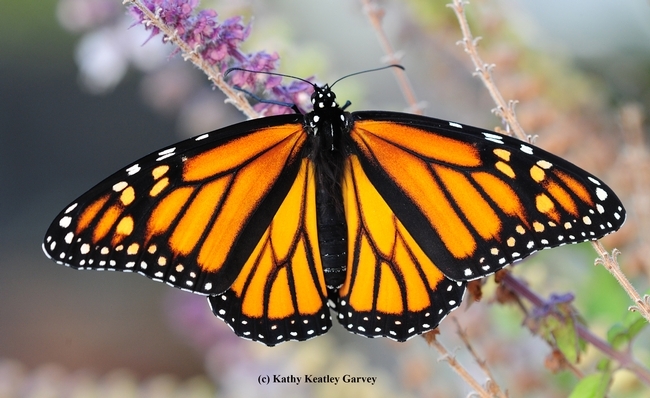
A female monarch butterfly spreads its wings. (Photo by Kathy Keatley Garvey)
Mitchell-led CASI honored by Soil and Water Conservation Society
Conservation Agriculture Systems Innovation has been named the 2022 recipient of the Conservation Innovation Award by the Soil and Water Conservation Society, an international organization based in Ankeny, Iowa.
“This is a very nice honor… and it has been achieved by, truly, the combined work and efforts of so many,” said Jeffrey P. Mitchell, UC Cooperative Extension specialist in UC Davis Department of Plant Sciences, who helped found CASI and has been instrumental in its leadership.
CASI, part of UC Agriculture and Natural Resources, started in 1998. It was formed by farmers, scientists and representatives of public agencies, private industry and environmental groups who aimed to develop knowledge and exchange information about the benefits of reducing tillage in agricultural lands.
Traditional practices such as tilling and plowing the land in preparation for crops are ingrained in agriculture. However, research has revealed that these practices cause soil erosion, dust and water run-off, and release greenhouse gases. In contrast, farmers and ranchers who have adopted the alternatives to tillage that CASI has been developing and evaluating see improved soil, better water infiltration and storage, less dust and lower costs, Mitchell said.
In the last 25 years, the no-till and low-till systems being explored by CASI have been widely adopted in much of the United States and in South America. But, in California's Central Valley, less than 1% of production acreage is farmed using conservation tillage. That's “largely because producers lack information, and successful examples of CT systems are only now being developed here,” CASI reported.
Now with more than 1,500 active members and affiliates, CASI conducts annual conferences to share research and the results of demonstration projects.
Mitchell's leadership of CASI praised
“Huge congratulations, Jeff, for your visionary and literally selfless leadership, always listening and learning, always humble. Thanks for taking us to new frontiers and possibilities of alternative futures. Thanks for showing us other ways to be a leader!!” – Kate Scow, UC Davis Department of Land, Air and Water Resources
“The team is special because everyone is sharing and learning as one. And, because your leadership has enabled us to all be more than the sum of the parts.” – Eric Kueneman, former global director of the United Nations Food and Agriculture Organization programs in Rome
“It was a pleasure to support the great work that this group does to change the farming paradigm in California.” – Cary Crum, California Ag Solutions
“Jeff is a modest person, but his achievements are numerous and span the gamut of extension, research and teaching. He has contributed enormously to our department through his innovative teaching, his inclusive extension work and his dynamic classroom teaching.” – Paul Gepts, UC Davis Department of Plant Sciences
The center's next project is to expand research and demonstration projects, acquire equipment, expand training and develop greater incentives for farmers to adopt conservation tillage in California.


